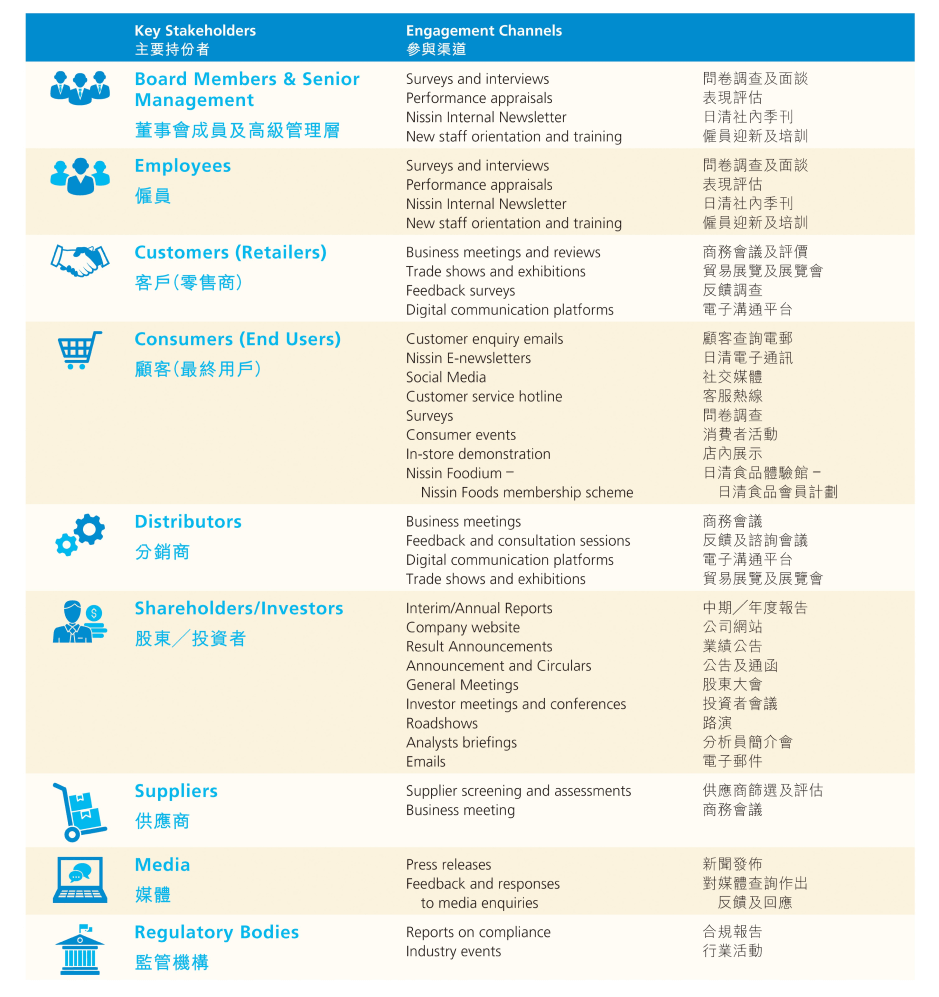Recognising the importance of effective stakeholder engagement, we highly value each stakeholder group’s unique role and employ tailored engagement channels to gather different opinions and expectations that they consider material to our operation and development. We leverage the opinions of our stakeholders in our business activities to promote and enhance our sustainable development.

Materiality Assessment
Step 1: Issue and Topic Identification
By conducting initial research and engaging stakeholders, we identified and prioritized 11 core areas that align with evolving industry trends and market expectations. This year’s assessment also introduced two new topics: Water and wastewater management, due to heightened regulatory scrutiny and global concerns over water scarcity, particularly in regions where we operate; and Selling practices and product labelling, in response to growing consumer demand for transparency, stricter regulations on marketing claims (e.g., health or sustainability), and the need to build trust through accurate, ethical communication.
Step 2: Issue Prioritization
Stakeholders took part in an online survey to assess the significance and applicability of various issues affecting Nissin Foods. We created and distributed a set of comprehensive surveys for stakeholder involvement and materiality evaluation to our primary stakeholders. These surveys were crafted to gather their insights regarding the materiality impact and financial implications of each identified ESG issue. Our aim is to comprehend not just how these topics directly affect our operations, but also how important they are seen from the perspective of our stakeholders.
Step 3: Issue Validation
We held an internal focus group session with the company’s leadership and those responsible for managing risks. The purpose was to evaluate and confirm the effects of the highlighted topics. Through these interviews and focus group talks, we achieved a better understanding of how these topics are significant both to our stakeholders (their materiality) and to Nissin Foods’s financial performance (its financial materiality). The results of this comprehensive process of identification, prioritization, and validation were combined and considered in the sensing model to create the dual materiality matrix.
Step 4: Strategic Alignment, Communication and Planning
The materiality assessment verified that the identified sustainability topics are well-aligned with our strategic goals and plans. New priorities, including Water and wastewater management and Selling practices and product labelling, have emerged from a thorough and inclusive evaluation through the concept of double materiality. Moving forward, we plan to discuss and examine how to effectively integrate these new priorities into our sustainability strategy with Management Committee at the board level for proactive management.
Step 5: Disclosure of Material Issues
We adopted the double materiality matrix, which is a commonly adopted framework for identifying and illustrating a company’s material ESG topics from both a financial materiality perspective (which considers the economic impact of ESG issues on the company) and an impact materiality perspective (which evaluates the social and environmental impacts of the company’s operations). The matrix helps stakeholders understand how ESG factors affect a company’s financial performance and its broader societal and environmental impacts. Under the new double materiality mechanism, we identified eleven material topics, summarised below:

